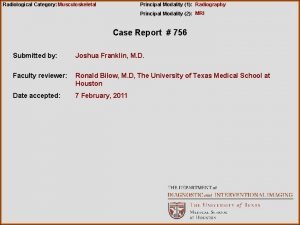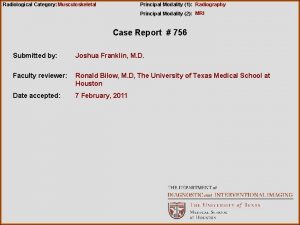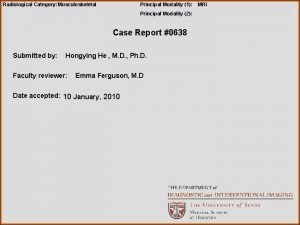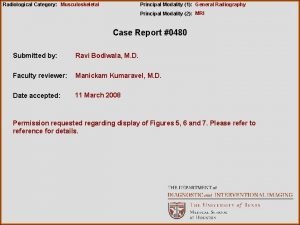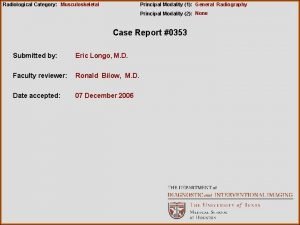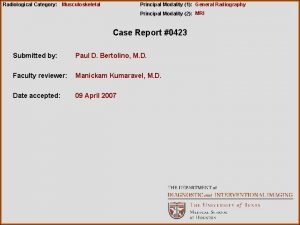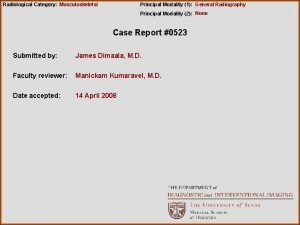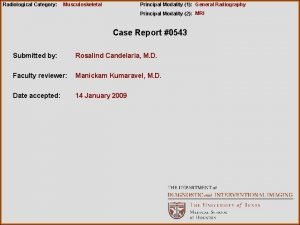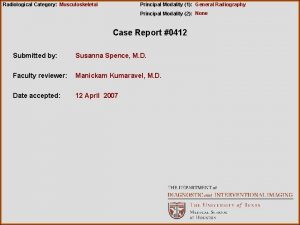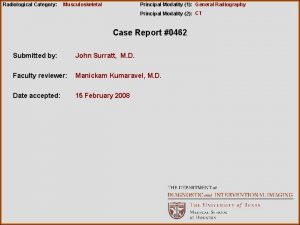Radiological Category Musculoskeletal Principal Modality 1 General Radiography











- Slides: 11

Radiological Category: Musculoskeletal Principal Modality (1): General Radiography Principal Modality (2): None Case Report #0279 Submitted by: Eric Longo, M. D. Faculty reviewer: O. Clark West, M. D. Date accepted: 18 December 2005

Case History 80 year-old male with remote history of prostate cancer recently diagnosed with pancreatic mass and multiple liver lesions. Patient with complaint of painfully enlarging left thumb mass over the last three months. No prior history of trauma of injury to the thumb is noted.

Radiological Presentations

Radiological Presentations

Radiological Presentations

Test Your Diagnosis Which one of the following is your choice for the appropriate diagnosis? After your selection, go to next page. • Metastasis • Giant Cell Reparative Granuloma • Epidermoid Inclusion Cyst • Tuberculosis Infection

Findings and Differentials Findings: An osteolytic lesion is present in the tuft of the 1 st proximal phalanx. The lesion arises from cancellous bone and breaches the cortex ventrally. The bony margin of the mass is fairly well defined and a faint sclerotic margin may be discerned. The mass extends into the ventral soft tissues. There is no matrix mineralization. Differentials: • Metastasis • Epidermoid Inclusion Cyst • Glomus Tumor • Tuberculosis • Giant Cell Reparative Granuloma • Sarcoidosis

Discussion Glomus tumors of the distal phalanx arise from the neuromyoarterial glomus, a specialized vascular anastomotic network surrounded by nerve elements responsible for regulation of body temperature. These hamartomas are soft tissue tumors found under the nail, in the nail bed. Subsequently, the lesion grows causing mass effect on the dorsal surface of the distal phalanx. The margins are well defined and often sclerotic. The patient’s lesion arises from bone and appears more aggressive. Epidermal inclusion cysts are found in the skull and distal phalanges. A penetrating trauma can implant dermoid elements into adjacent bone and incite a foreign body reaction. The inciting incident by remote, even decades in the past before clinical symptoms present. Pathology reveals keratin, sebaceous material, reactive tissue and debris. The patient often complains of redness and pain at the site. Radiographically, there is a well defined lucent lesion within the bone, often surrounded by a sclerotic rim, causing destruction and expansion of the bone with soft tissue swelling. Radiographically, the lesion matches the description, but the patient gives no history of trauma. Giant cell reparative granuloma is a rare lesion that presents in the small bones of the hands and the feet, but also the craniofacial bones. They are typically seen in patients age 10 -25 years and are thought to be post traumatic, but origin remains uncertain. Histologically, they are composed of stromal cells and multinucleated giant cells. The lesions arise centrally within bone, as in this patient’s, but despite expansion,

Discussion the periosteum remains intact. The patient’s lesions has violated the cortex and periosteum with no host bone response. The patient’s clinical history is also discordant with this diagnosis. Sarcoidosis produces granulomas adjacent to or within bone which grow causing osteolysis without host bone response. The radiologic appearance can vary from cyst like lesions, to a lattice or lace-like appearance of bone due to multiple granulomas, to complete acroosteolysis with autoamputation. The middle and distal phalanges are most often involved. The soft tissue component has been referred to as “pseudoclubbing”. The radiographic appearance can not exclude sarcoidosis in this case. Metastases to the distal phalanges are not uncommon, and when they occur are often seen in bronchogenic carcinoma and renal cell carcinoma. The appearance is variable; however, a wider zone of transition with the involved bone would be expected instead of a well delineated margin as displayed in this patient. However, given this patient’s remote history of prostate cancer, which may also produce lytic metastases, and newly diagnosed pancreatic mass with possible liver metastases, this diagnosis must be entertained. Finally, tuberculous osteomyelitis may have this appearance. Osteolysis with clear cut margins, lack of reactive bone, and soft tissue mass suggest a slower course than pyogenic osteomyelitis. Tuberculosis of the digits is termed spina ventosa. Periosteal reaction is followed by bony expansion. This has been well described in children.

Diagnosis Leading differential diagnoses in this patient should be epidermoid inclusion cyst, sarcoidosis, tuberculosis, and metastasis. Pathologic specimen showed no evidence of acute inflammation or infection despite the patient’s clinical presentation of erythema and tenderness to palpation. Abundant mature-appearing keratinizing squamous cells were present. The cells were bland with very minimal nuclear atypia. This supports the diagnosis of epidermoid inclusion cyst. The patient denied history of trauma, however, the incident could have been remote (decades). The patient did complain of pain and radiographic findings support the pathologic diagnosis. Treatment is surgical excision or curettage.

Reference Chew, F. Maldjian, C. Leffler, S. Musculoskeletal Imaging: A Teaching File. Lipponcott, 1999.
 Erate category 2
Erate category 2 Center for devices and radiological health
Center for devices and radiological health National radiological emergency preparedness conference
National radiological emergency preparedness conference Radiological dispersal device
Radiological dispersal device Tennessee division of radiological health
Tennessee division of radiological health Pacs modality workstation
Pacs modality workstation Monode electrode
Monode electrode Exteroceptors
Exteroceptors Sodality vs modality
Sodality vs modality Epistemic modality
Epistemic modality Cardinality and modality
Cardinality and modality Cardinality and modality
Cardinality and modality












